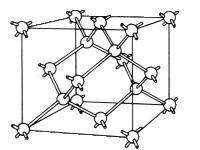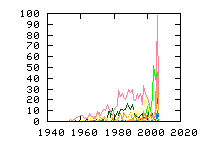« Previous
1
Next »
(9 hits, 1/1)
Showing
10, 25, 50, 100, 500, 1000, all papers per page.
Sort by:
last publication date,
older publication date,
last update date.
- 1. Appl. Phys. Lett. 89, 152123 (2006) , “Electrical characterization of defects introduced in n-type Ge during indium implantation”, F. D. Auret, P. J. Janse van Rensburg, M. Hayes, J. M. Nel, W. E. Meyer, S. Decoster, V. Matias, and A. VantommeThe authors have employed deep level transient spectroscopy to investigate the defects introduced in n-type Ge during 160 keV indium (In) ion implantation. Our results show that In implantation introduces three prominent electron traps with energy levels at... (Read more)
- 2. Appl. Phys. Lett. 84, 3406-3408 (2004) , “Structure of 6H silicon carbide/silicon dioxide interface trapping defects”, David J. Meyer, Nathaniel A. Bohna, and Patrick M. LenahanWe utilize spin-dependent recombination (SDR) to observe deep level trap defects at or very near the interface of 6H silicon carbide and the SiO2 gate dielectric in SiC metal-oxide-semiconductor field effect transistors. The SDR response is strongly correlated to SiC/SiO2... (Read more)
- 3. Eur. Phys. J. Appl. Phys. 27, 13-19 (2004) , “Measurement of process-induced defects in Si sub-micron devices by combination of EDMR and TEM”, T. Umeda, A. Toda, Y. MochizukiProcess-induced defects are a serious issue for modern sub-micron Si LSIs. To characterize such defects, two different techniques are useful: electrically detected magnetic resonance (EDMR) and transmission electron microscope (TEM), which can detect small (point) and extended defects, respectively. We applied EDMR and TEM to the issue of defect-induced leakage currents in dynamic-random-access memory (DRAM) cells. For our DRAM samples (a 0.25- μm-rule series), although TEM showed no extended defects, EDMR successfully detected two types of point defects: V2+O x (Si divacancy-oxygen complexes) and larger Si vacancies (at least larger than V6). We confirmed that these defects are the source of DRAM leakage currents. The observed defects were formed by ion implantation processes, but were more thermally stable than those in bulk Si crystals. The origins of this enhanced stability are attributed to the presence of oxygen atoms and a strong mechanical strain in LSIs. To clarify the origin of the complicated strain in LSI structures, we can directly measure the local-strain distribution in DRAM samples by means of convergent-beam electron diffraction (CBED) using TEM, which provides us with a valuable hint for understanding the formation mechanism of process-induced defects. (Read more)
- 4. J. Appl. Phys. 94, 7105-7111 (2003) , “Electrically detected magnetic resonance of ion-implantation damage centers in silicon large-scale integrated circuits”, T. Umeda, Y. Mochizuki, K. Okonogi, K. HamadaWe used electrically detected magnetic resonance to study the microscopic structure of ion-implantation-induced point defects that remained in large-scale Si integrated circuits (Si LSIs). Two types of defects were detected in the source/drain (n+-type) region of... (Read more)
- 5. Physica B 302-303, 212-219 (2001) , “Magnetic resonance studies of shallow donor centers in hydrogenated Cz–Si crystals”, B. Langhanki, S. Greulich-Weber, J. ?M. Staeth, V. P. Markevich, L. I. Murin, T. Mchedlidze, M. Suezawa.A complex magnetic resonance study (EPR, electrically detected EPR, ENDOR) of hydrogen-related radiation-induced shallow donors in silicon has been performed. Three species of this donor family (D1–D3) were observed earlier by means of infrared absorption measurements in hydrogenated... (Read more)
- 6. Mater. Sci. Forum 83-87, 1165-1170 (1992) , “Spin dependent recombination at deep centers in Si - electrically detected magnetic resonance”, P. Christmann , M. Bernauer , C. Wetzel , A. Asenov , B. K. Meyer , A. Endros
- 7. IEEE Trans. Nucl. Sci. 37, 1650-1657 (1990) , “Spin dependent recombination: A 29Si hyperfine study of radiation-induced Pb centers at the Si/SiO2 interface”, M. A. Jupina , P. M. Lenahan
- 8. Appl. Phys. Lett. 44, 228-230 (1984) , “Optically induced electron spin resonance and spin-dependent recombination in Si/SiO2”, B. HendersonIn state-of-the-art Si/SiO2 wafers the concentration of paramagnetic interface states (1010 cm–2) is almost too low to be detected by electron spin resonance (ESR). This letter describes experiments which show that the ESR signal of singly occupied dangling bond... (Read more)
- 9. J. Appl. Phys. 49, 2401-2406 (1978) , “Resistance changes induced by electron-spin resonance in ion-implanted Si : P system”, K. Murakami, S. Namba, N. Kishimoto, K. Masuda, K. GamoThe ESR-induced changes in the dc resistance, /||ESR, of P-ion-implanted silicon have been observed for the first time. The transfer of absorbed Zeeman energy at liquid-He temperature has been investigated. The /||ESR signals observed were a narrow line with a g value of... (Read more)
« Previous
1
Next »
(9 hits, 1/1)
Showing
10, 25, 50, 100, 500, 1000, all papers per page.
Sort by:
last publication date,
older publication date,
last update date.
All papers (3399)
Updated at 2010-07-20 16:50:39
Updated at 2010-07-20 16:50:39
(view as: tree
,
cloud
)
| 1329 | untagged |
Materials
(111 tags)
Others(101 tags)
Technique
(46 tags)
Details
(591 tags)
Bond(35 tags)
Defect(interstitial)(18 tags)
Defect(vacancy)(15 tags)
Defect-type(19 tags)
Element(65 tags)
Energy(8 tags)
Isotope(56 tags)
Label(303 tags)
Sample(17 tags)
Spin(8 tags)
Symmetry(15 tags)

